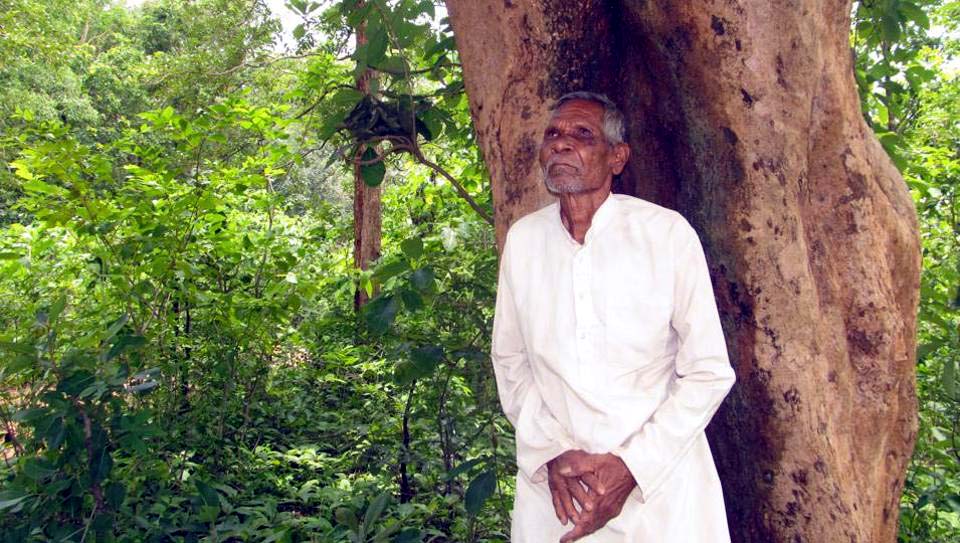Kartik Manjhi groomed a 97-acre barren land in one of India’s poorest regions into a forest with painstaking effort for three decades.
Forest officials say the work by Majhi and local tribals in Kalahandi is an important step in guarding the forest resources. In a region where deprivation sweeps away any shred of hope and optimism, Kartik Majhi stands out.
The septuagenarian Kondh tribal from Kalahandi’s Boringpadar village may not have studied much, but has brought cheer and hope to a place where death is an annual feature.
In 1979, Majhi started planting sapling on the 97 acre barren land adjoining a hillock near his village with support from the Nehru Yuva Kendra. Villagers who used to grow millet on that land had no idea what Majhi was up to, but grudgingly came around to support him for next three years.
Some 35 years later, the 97 acres of once-barren land near his village is home to a luxuriant forest consisting of Sal, Teak, Acacia, Chakunda and several other timber and fruit-bearing trees. In the process, he showed the ability of free Indians to battle the most adverse of circumstances, and the transformation that takes place when society and state collaborate.
Epicentre of starvation
Kalahandi in the 60s was known as Ethiopia of India for its acute starvation triggered by long periods of drought. After a particularly protracted spell of drought in 70s and 80s that forced poor parents to sell their children, former Prime Minister Rajiv Gandhi visited the region. While its forested landscape was being slowly eroded by timber smugglers who valued the rich Kalahandi teak, the shifting cultivation of tribals took its toll on the forest cover
“When I was young I came to realise that without rains we would not have any hope. My father told me that the only way we can have regular rains is through forests,” said Majhi. This was the time when a young Majhi got serious about ways to prevent drought.
With some handholding by local forest officials and help from Nehru Yuva Kendra in Bhawanipatna, Majhi and his elder brother Bali through Boringpadar Yuvak Sangha started planting saplings on the barren land, that was recorded as forest in government files. Soon the rest of the villagers joined in. The remunerations were not great – all that the villagers got was a sack of potatoes and two sacks of rice.
“At times when people were not willing to go for planting, I used to mortgage my umbrella and utensils at home to pay people and a security guard to keep an eye on the saplings,” said Majhi, standing next to a sal tree which he planted. Tejiraj Pradhan, a young farmer, still remembers how he used to plant saplings with Kartik mausa.
The transformation
Ten years later as the saplings grew in length, the once-barren area sported a different look. “It was like seeing a desert bloom,” said Majhi’s friend Kirtan Majhi.
Impressed with his work in creating a forest out of a barren land, the forest department in late 90s entrusted Boringpadar Yuvak Sangh the task of looking after the 500 hectares of reserve forest near his village. The villagers also keep an eye on another 500 hectares of forest near the hills adjacent to the village.
Forest officials say the work by Majhi and local tribals in Kalahandi is an important step in guarding the forest resources.
“Creating a forest and guarding can never be done by the forest department if individuals like Majhi are not involved. A forest guard is supposed to guard an area of 20-25 km. Is it possible on his part to keep an eye on so large an area,” asked Suresh Pant, regional chief conservator of forests of Bhawanipatna.
Preserving the legacy
Despite efforts by Majhi, old-timers of the district are not so hopeful of seeing the luxuriant forest cover of mid-80s when 50% of its geographical area was under forest cover. The last Forest Survey of India published in 2015, put the forest cover at 30%. “The success of people like Majhi is important, but it’s very difficult to get back what we lost,” said former Kalahandi MP Bhakta Charan Das.
Now 75, Majhi can’t walk properly and has problems in his sight. But his son Shankar seems to have inherited his father’s legacy as he goes to the forest with his friends to keep an eye on anyone cutting forests. This year a dozen villagers entered the reserve forest area and tried to cut the trees. They were promptly fined Rs 6,000 by the Yuvak Sangh volunteers.
Majhi says forests are intrinsic to the well-being of tribals. “We can’t always travel to the hospital in Narla block, which is 15 km away. If we suffer from malaria, we take crushed leaves of Nyctanthes, black pepper mixed with honey. The forests give us everything. Jungle is mangal for us,” said Majhi.
http://www.hindustantimes.com/india-news/india-at-70-how-a-75-year-old-tribal-man-grew-a-lush-forest-in-impoverished-kalahandi/story-MlhS4GTNoKoO6ZQirnDgPJ.html


